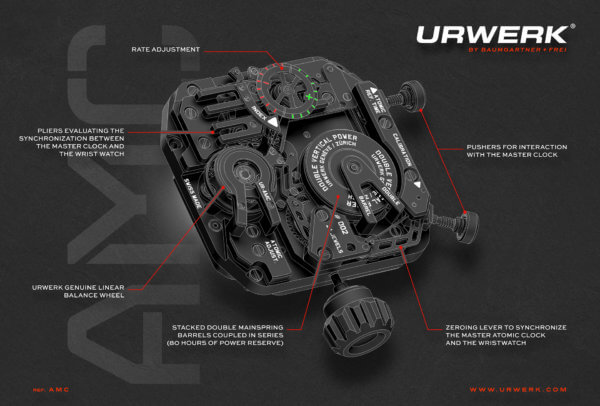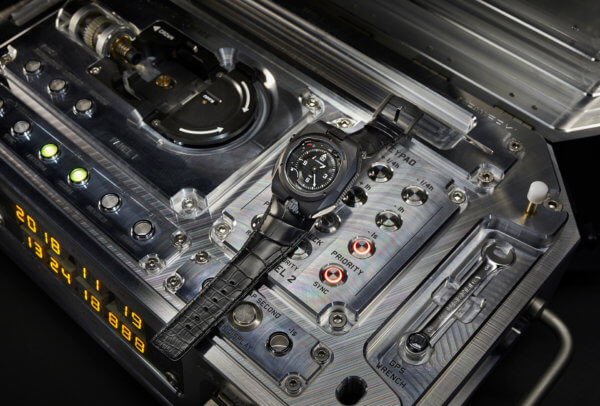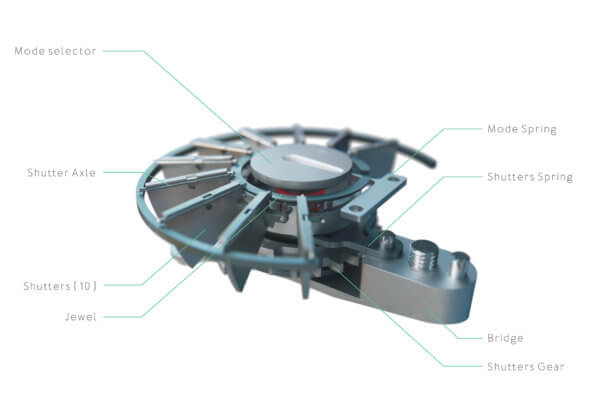“Urwerk co-founder Felix Baumgartner confirms peaceful intentions. Rubidium ion oscillator guarantees 317 years of chronometric precision to within one second, over. “Copy. Ressence cleared. Small quantities of light energy used to drive the Type 2’s smart crown. Evacuation aborted. Over and out.” As you’ll have guessed from this (entirely fictious!) exchange, Urwerk and Ressence are breaking the mould this year with mechanisms that run on energies rarely – if ever – seen before in watchmaking: atomic energy in Urwerk’s case and light energy for Ressence.
The AMC and Type 2 share another unusual characteristic in that they are self-regulating. Usually, the rate of a mechanical watch has to be adjusted by a watchmaker who carefully alters the active length of the balance spring by moving a component, the racket, to different positions. Not the AMC or the Type 2: both are mechanical and both keep accurate time with neither the help of a watchmaker nor through any kind of satellite or radio hook-up. These guys go it alone!
In synch
When developing the AMC, Felix Baumgartner looked to the sympathique clock which Abraham-Louis Breguet invented in 1795. In Breguet’s system, at midnight a master clock mechanically sets a pocket watch to its reference time. Transposed to Urwerk’s twenty-first century world, this master clock, or rather base unit, is atomic and goes by the name of Monolith. Thanks to rubidium ions, its precision far and away exceeds that of a quartz oscillator as it deviates by a maximum of one second in 317 years, compared with one to two seconds a day.

While atomic clocks have been around since the middle of the twentieth century, this is the first time a watchmaker has used one to wind, set and regulate a mechanical wristwatch. At midnight minus a few seconds, the base unit triggers a pusher which, via a mechanical system, controls and, if necessary, corrects the precision of the watch’s seconds display. At midnight, a second pusher is triggered which sets the hour and minute hands to zero. A shaft extends from the base unit to wind the wristwatch by the crown. The multi-tasking Monolith will even improve the AMC’s precision. When the wristwatch is docked on the base, a sensor mechanism transfers the information required to regulate its precision. This synchronisation can be activated manually or at pre-set intervals. By docking the watch first on a daily basis, then every three days, then once a week, it gradually becomes calibrated to the wearer’s individual lifestyle and activity.

The AMC watch isn’t a slave to the Monolith (which tips the scales at 35 kilos), thanks to its 80 hours of power reserve and manual winding via the crown. Urwerk will produce just three of this clock/watch combination, one of which has already been sold.
Tap, tap, it's time!
Blowing kisses on Instagram, clicking a computer trackpad or waking up a smartphone: double tapping has become part of our connected lives. Belgian brand Ressence builds on what is now an intuitive gesture to create a new means of interacting with a watch, by associating the Type 2’s mechanical automatic calibre with its own, patented e-Crown or smart crown.

And smart it is, as the Type 2 is capable of recognising movements. When the wearer moves or taps the watch’s crystal, the system comes alive. The minutes disc makes a small forward-backward rotation (think of it as an early-morning yawn). Tap again to select the function: time zone 1, time zone 2, Bluetooth or e-Crown off. The time is set by a lever on the case back, or by a Bluetooth connection to an app. The reference time is digitally registered. If the Type 2 remains inactive for more than 12 hours (which should be enough sleep for anyone!), the e-Crown mechanically stops the barrel to save energy. A double-tap restarts the movement and sets the time.
For complete self-sufficiency, the e-Crown runs off light energy. Photovoltaic cells, certain of which are under the dial, capture sufficient outside light for “normal” use. If the temptation to show off this innovative technology becomes too great, there is also a lamp for fast charging. If in doubt, the app indicates how much power remains.

So what’s it to be? An atomic bang or a solar tan? The choice is yours.




















